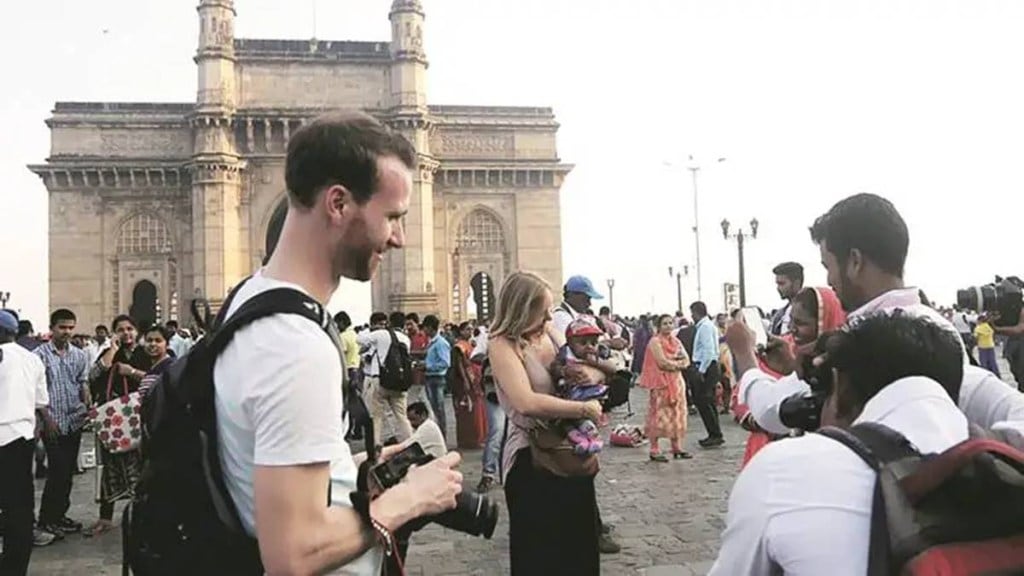Tourism could be India’s biggest source of export earnings, free from tariffs. However, that will require a massive infusion of funds not just to promote India as a prime destination for foreign tourists but also build the necessary infrastructure, writes Banasree Purkayastha.
l Why tourism is in the news
Following the 50% US tariffs imposed on India, former NITI Aayog CEO and G20 Sherpa Amitabh Kant has said tourism is the sector that can compensate for potential losses. Kant, who spearheaded the successful ‘Incredible India’ campaign of the 2000s, urged India to turn the challenge of restrictive US trade tariffs into an opportunity for ushering in economic reforms — with a huge bet on tourism to bring in the dollars. “This is the moment to ensure that we become the most competitive economy in the world. You need to look at sectors that will drive India’s growth story with job creation. This sector — tourism —can compensate for Trumpian tariffs more than any other sector by penetrating every global market with a brand campaign that will get you tourists from across the world,” he said at a Federation of Associations of Indian Tourism and Hospitality meet last week. Kant also called for Rs 20,000 crore for the tourism industry to promote India and penetrate global markets. “A large country like India having a tourism budget of just `3 crore is absurd,” he said.
l Potential of this sector
The world travel and Tourism Council (WTTC) has projected that the travel and tourism sector will contribute almost `42 lakh crore to India’s economy by 2035, supporting 64 million jobs. By 2047, the goal is to become a $3 trillion tourism economy generating 100 million inbound tourists, 20 billion domestic visits and 200 million tourism-related jobs. In 2024, India recorded 9.95 million Foreign Tourist Arrivals (FTAs). However, this is still below its 2019 peak. The silver lining – FTAs ensured a 10.15% rise in Foreign Exchange Earnings (FEEs) at Rs 2.9 lakh crore in 2024 against the previous year. Meanwhile, a Capitalmind PMS report says South Asia (29.02%), North America (21.82%), and Western Europe (20.4%) were the top sources, with leisure travel (46.2%), diaspora visits (26.9%), and business travel (10.3%) driving arrivals. It estimates the Indian tourism sector to generate over Rs 5.13 lakh crore by 2028, with FTAs hitting 30.5 million.
l How India compares with other nations
India has only 200,000 hotel rooms against China’s 20 million. The government still owns 495 hotels despite a disinvestment drive, and most of them run at a loss. Nationals from only three countries — Bhutan, Nepal and the Maldives — can travel to India without a visa. In contrast, citizens from 70 countries can enter China without a visa, 90 can enter Thailand. India accounts for just 1.5% of global tourist arrivals; average spending by a foreign tourist in India is Rs 2.9 lakh. Tourism’s contribution to GDP is just around 5%. As author Anand Ranganathan wrote on X, a small city like Paris attracts 25 million foreign tourists every year. In contrast, India gets less than 11 million tourists a year. “We have 42 World Heritage Sites. Greece has half those, and yet we attract one-third of the foreign tourists that Greece does,” he said.
l What’s holding India back
As IndiGo CEO Pieter Elbers said, a promotional campaign only works if the basics — visas and ease of travel — are fixed first. The process of getting a visa isn’t easy, and despite all the talk of Digital India, paper copies remain the norm. Lack of cleanliness, poor AQI can put off the hardiest of tourists. The first impression as the flight lands can’t be a slum on the side of a runway. Poor infrastructure, including rickety transport facilities, lack of clean washrooms, safety issues, inadequate site maintenance dissuade the foreign tourist from travelling beyond the major tourist spots. As Ranganathan pointed out, “We have the Bodhi Tree. Japan, South Korea, China — they would be falling over each other to make Bodh Gaya the Vatican of the East,” he said. “And yet the annual municipal budget of Bodh Gaya is less than the production budget of the failed movie Adipurush — Rs 500 crore.”
l Focus on the high-spending tourist
While all these problems need to be tackled to make India more inviting, care has to be taken that cranking up tourism development does not come at the cost of the environment. Eco-tourism also holds appeal with the foreign tourist. Religious tourism, especially in difficult-to-access places, holds immense potential but has to be managed in a calibrated way. As Kant said, India should focus on attracting high-spending, long-stay travellers rather than chasing volume. He added, “Go for high-value tourism, for people who want to experience India’s culture, heritage, and architecture. These are the days of experiential tourism.”
There is also an urgent need for joint promotions with industry, states and brands. Past initiatives like the “Incredible India” campaign have been successful in raising the country’s profile as a tourist destination. Experts say it’s time now to launch a fresh campaign as there’s been no real global campaign in the past decade. States also need to develop distinctive tourism brands. However, effective marketing strategies need to be backed by an efficient, user-friendly tourism experience.

